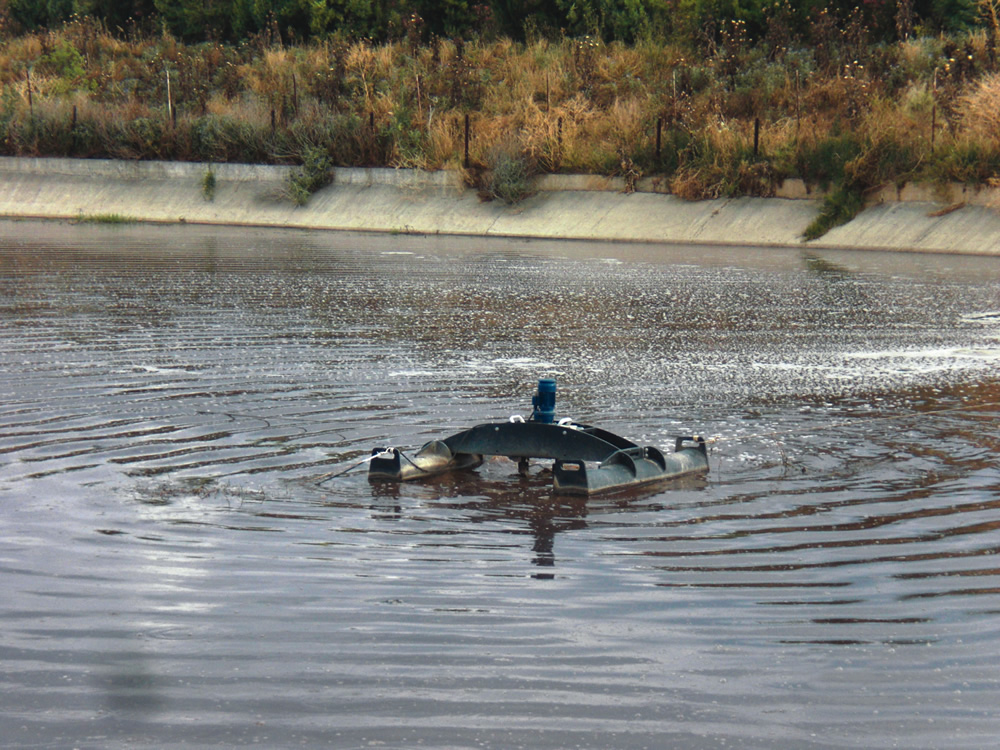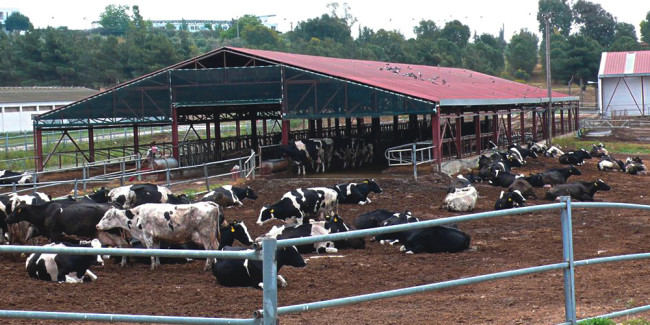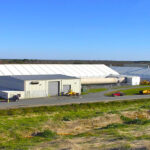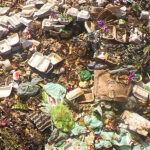A holistic model is employed at the American Farm School in Thessaloniki, Greece to treat and recycle its solid and liquid waste.
Petras, G. Theodoridou and N. Nikolaidis
BioCycle December 2013
The farm includes 120 cows and 100 calves, as well as 22,000 turkeys and 15,000 chicken.[/caption]For over a century, the American Farm School (AFS) in Thessaloniki, Greece has been a strong advocate of the holistic concept in education. Dr. John Henry House, founder of the school, used to say, “To educate the whole individual: the head, the hands, the heart.” Students at the School learn math as well as plowing. The campus houses 470 students and staff, with another 150 living off-campus.
A holistic model also has been employed for many decades to treat and recycle AFS’ solid and liquid waste. Liquid waste comes from the campus and its educational farm. The farm includes 120 cows, 100 calves, 22,000 turkeys and 15,000 chicken. All liquid waste, including campus sewage, milking house and milk processing effluent, barn effluent and composting facility runoff, is collected and treated.
The treatment facilities include a two stage activated sludge plant, vertical flow reed beds, a concrete aerobic lagoon (Lagoon A) and a final storage lagoon (Lagoon B). The Plocher Energy System, a holistic approach of environmental management, has been used since 1996 (Willis and Nikolaidis, 2005) with the following objectives:
Maintain strictly aerobic conditions and reduce pollutants and odors; ORP (oxidation reduction potential) monitoring is used throughout the year for measurement of aerobic activity levels.
Minimize sludge quantities and improve sludge quality.
Maintain high effluent quality in the storage lagoon and sustain efficient water use by the irrigated crops.
Liquid Waste Treatment
Liquid waste at the AFS is separated into two lines of treatment: nonanimal liquid waste and waste of animal origin. The nonanimal liquid waste line includes human sewage, milk processing, slaughterhouse and winery wastewater. It is treated in the school’s activated sludge wastewater treatment plant — a two stage process using coarse bubble air diffusers. An automatic coarse screen and a fine screen (a rotating drum to separate solids of 0.4-inch (1 mm) size) are used for pretreatment. Excess sludge is pumped to Lagoon A for further treatment. Wastewater from the slaughterhouse facility also goes through a coarse and a fine screen and then flows into Lagoon A for further treatment.
The animal liquid waste slurry is delivered to the treatment facility in a small tank pulled by a tractor. The slurry is emptied into a homogenization tank. Wastewater from the milking facility is pumped to the same tank to give the right consistency to the slurry. The homogenized slurry is pumped to a solids separator; the liquid part flows to Lagoon A for treatment. Solids greater than 0.3 inches (75 mm) are separated and treated (see below).
Lagoon A has a depth of 20 feet (6 m) and a volume of 20,000 m3 and accepts a considerable amount of rain runoff. Several treatment systems are used to maintain aerobic conditions and reduce odors, digest and minimize sludge settled to the lagoon bottom and improve the water quality flowing to Lagoon B. Since 2007, vertical flow reed beds provide direct treatment of the organic load in the lagoon, improving the microbial quality of the wastewater. The 16 circular beds, each planted with Phragmites Australis spp., are 6.5-feet (2.0 m) in diameter and 5-feet (1.5 m) high. Up to 230 m3/day of wastewater may pass through the beds, which operate intermittently. Various organic loading rates have been attempted. The reeds are harvested once a year and the top layer (sand) is cleaned and replenished. In addition, a floating aerator supplied by Oloid has been in use since 2009. It effectively mixes the contents of the lagoon, especially the bottom sludge, so that it can be pumped and processed.
After a number of years of slow digestion, sludge in the lagoon is liquefied and made suitable for pumping. During the dry warm months (April to October), sludge is pumped to an asphalt pad and allowed to dry. It is odorless and regularly analyzed for soil application suitability. This process stops during the wet season.
All treated wastewater is collected in Lagoon B for recycling. The lagoon has a depth of 13 feet (4 m) and a storage volume of 40,000 m3. It accepts rain runoff as well from part of the AFS campus. Water is stored during the winter months and is used for crop irrigation from May to September. A UV unit has been installed for disinfection of the final effluent before irrigation.
A portion of the animal manure from the School’s livestock is composted in an in-vessel facility. The rest is stored and allowed to mature for almost a year. Most of the finished compost is used by AFS for soil amendment, animal bedding etc. Stored manure is distributed to farmers in the wider area of Thessaloniki, following a specific application program. The procedure is closely monitored by the School so that correct farming and sound environmental practices are followed by the farmers. About 5,200 cubic yards (4,000 m3) of manure are distributed annually.
Treated Effluent Recycling
The hot dry summers in Greece are very demanding in terms of irrigation. The School operates a state of the art recycling system for crop irrigation. Wheat is being cultivated in the winter and corn in the summer. Both crops are used for AFS animal feed. Corn is harvested and turned into silage on the campus.
A new strict effluent reuse legal framework has been in place since 2011 (Ministry of Environment, 2011). The AFS has successfully met the requirements and obtained the relevant approval (Theodoridou and Nikolaidis, 2012). The parameters in question were: Long term effects of effluent recycling on the AFS soil; Efficient water use and sustainable nutrient balance; and Health and safety of AFS visitors and personnel.
Long Term Effects: The long term effects on the soil were studied by comparing soil analyses carried out in the years 1996 and 2012. Based on grain analysis, the AFS soils were characterized as clay loam or clay. The soil pH remained slightly alkaline in the range of 8.2 to 8.5. Organic matter in the soil dropped from 2.0 percent in 1996 to 1.5 percent in 2012. BOD5 in the treated effluent has traditionally been in the range of 70 to 150 mg/L. Higher organic matter inputs are required for keeping organic matter at satisfactory levels. Soil conductivity has gone up slightly (1.17 mS/cm in 1996 to 1.53 in 2012). The micronutrient levels in the soil have not changed much between 1996 and 2012.
Water Use and Nutrient Balance: Overall irrigation water demands based on the climatic conditions in the area for corn cultivation range from 450 to 650 m3/str (1 str = 0.1 ha) which is equivalent to 450 to 650 mm or 17.5 to 25.3 inches. The area where corn is planted is close to 10 ha and the total treated effluent volume applied is approximately 50,000 m3 (19.5 inches). The same field is cultivated in the winter time with wheat. Corn planting follows right after wheat harvesting.
The average nutrient content in the treated effluent based on biweekly chemical water analyses, is 92mg/L total nitrogen (N) and 20mg/L total phosphorus (P). The annual nutrient amounts in the effluent water are 4,600 kg (5 tons) for N and 1,000 kg (1.1 tons) for P.
Both the organic and inorganic forms of N and P are included in these amounts. The Greek Agriculture Ministry’s Guidelines (Ministry of Agriculture, 2000, 2002, 2004) for sustainable cultivation methods call for the following fertilizer application rates: Corn cultivation—18 to 24 kg/str N, 0 to 4 kg/str P; and Wheat cultivation—9 to 18 kg/str N, 0 to 4kg/str P. The rates refer to inorganic N and P masses. The combined needs of the field (corn and wheat) therefore are 27 to 42 kg/str N and 0 to 8 kg/str P. The presence of nutrients in the recycled effluent is assumed to be 20 percent in organic form and 80 percent in inorganic form. Thus the yearly applied inorganic nutrient loading to the field is 32.2 kg/str N and 8kg/str P.
Health and Safety: One of the key issues in the new treated effluent legislation is the health and safety of community and workers. A number of practical requirements have been followed by AFS over the years regarding safe water application methods, worker protection and timing of applications. Microbiological quality of treated effluent is of primary importance and legislation calls for a maximum of 1000 colony forming units (CFU)/100 mL of E.Coli. Microbial quality analyses on a biweekly basis for 2011 and 2012 have shown E.Coli levels in the range of 0 to 20CFU/100mL and only one sample at 110CFU/100mL.
A.Petras is the Environment and Technical Works Manager at the American Farm School. G. Theodoridou is an Environmental Geologist Consultant to AFS. N.Nikolaidis Environmental Engineer Consultant to AFS.











